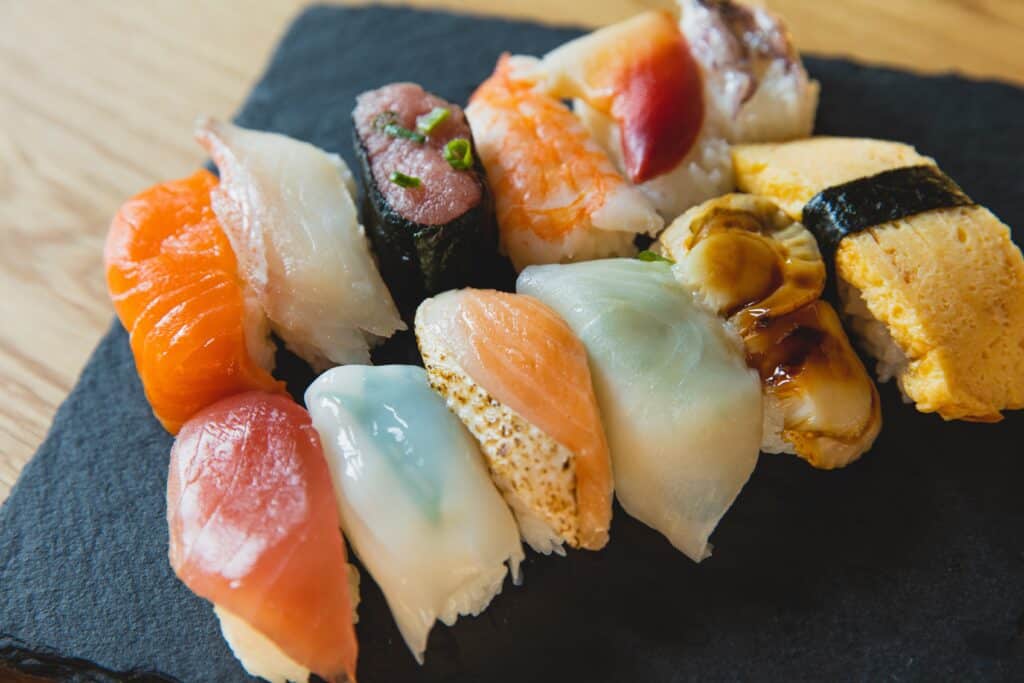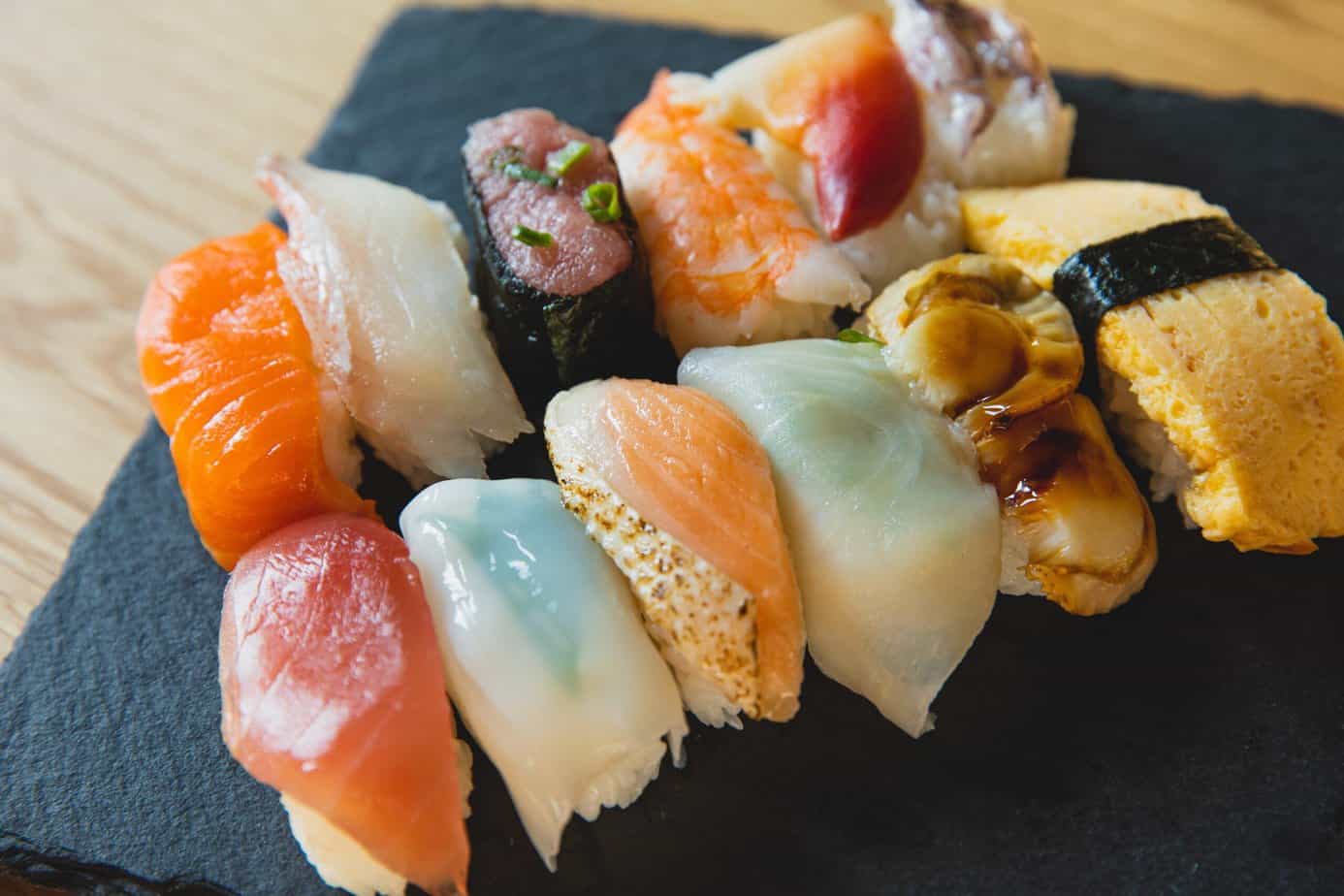Sushi can be eaten with chopsticks or forks.
But how to eat sushi? In this beginner friendly article, I will give you complete information on how to eat sushi for beginners but also provide the real reason that make sushi omnipresent in the food industry.
Sushi, is a dish originated from Japan. While many associate sushi with fresh fish and rice soaked in vinegar, few delve into the depths and centuries-old traditions for every piece of sushi that is being cooked.
The art of sushi-making is requires skills and craftmanship. Every sushi chef, or itamae, undergoes years of rigorous training to master not only the techniques but also the philosophy behind this revered dish.
The delicate balance of flavors, the precision in slicing fish, and the gentle pressing of rice are all choreographed movements that transform simple ingredients into edible art. But what many contemporary discussions miss is the deep-rooted tradition of sushi that dates back to the Edo period. Hanaya Yohei’s invention of nigiri-zushi in the 19th century was not just a culinary innovation; it was a reflection of the societal changes and urbanization of Edo (modern-day Tokyo).
Sushi became the fast food for the bustling city’s chōnin class, offering a quick and delicious meal for the busy urbanites.
While many sources, such as Yamashiro Hollywood and PBS, provide insights into the history and techniques of sushi, there’s a seldom-discussed aspect: the spiritual connection between the itamae and the ingredients.
The respect for the produce, the acknowledgment of the sea’s bounty, and the gratitude towards nature are all integral to the sushi-making process. This reverence is palpable in every bite, making the experience transcendent.
Furthermore, the Western adaptation of sushi has introduced a myriad of flavors and combinations, but the essence remains the same. The balance, the harmony, and the respect for ingredients are universal, transcending geographical boundaries.

Sushi Etiquette: Respecting the Craft
Sushi, with its intricate layers of flavor, texture, and presentation, is not just a dish—it’s a ceremonial experience. And like any ceremony, it comes with its own set of etiquettes that elevate the dining experience from mere consumption to a cultural immersion.
While many sources, such as Sushi FAQ and Bon Appétit, provide insights into the dos and don’ts of sushi etiquette, there’s more to the story than just using chopsticks correctly or not mixing wasabi in soy sauce.
The Silent Dialogue Between the Diner and the Chef
At the heart of sushi etiquette is the unspoken communication between the diner and the sushi chef, or itamae. When you step into a traditional sushi restaurant, especially in Japan, you’re not just a customer; you’re a participant in Japanese culture.
The itamae crafts each piece of sushi with precision and care, and as a diner, acknowledging this effort is paramount. A simple nod of appreciation or a compliment can bridge the gap between the chef’s counter and the diner’s seat, fostering a connection that transcends words.
The Art of Ordering
While many are familiar with the concept of ‘Omakase’—leaving the selection to the chef—it’s essential to understand its deeper significance. By choosing ‘Omakase’, you’re placing your trust in the chef’s expertise, allowing them to showcase their skills and the day’s freshest ingredients.
Savoring Each Bite
In the fast-paced world of quick bites and hurried meals, sushi urges you to pause. The best way to eat a sushi is to use the chopsticks and consume it in a single go. Rushing through a sushi meal is akin to flipping through the pages of a book without reading—it misses the essence.
Beyond the Basics
While most sushi etiquettes focus on the basics—how to use chopsticks, when to dip sushi in soy sauce, or how to consume pickled ginger—there’s a deeper layer that’s often overlooked. It’s about understanding the philosophy behind these etiquettes. For instance, refraining from pouring excessive soy sauce is not just about avoiding waste; it’s about respecting the ingredient and the chef’s intention.
The Hands or Chopsticks Debate: How to Eat Sushi the Right Way
The world of sushi is as vast and varied as the oceans from which its primary ingredients hail. But beyond the myriad of flavors and preparations lies a debate that has persisted for generations: should sushi be eaten with hands or chopsticks? While many sources, including discussions on platforms like Reddit and Quora, offer varied perspectives, the answer is more nuanced than a simple choice between fingers and utensils.
To truly understand the debate, one must travel back in time to the streets of Edo (modern-day Tokyo) during the 19th century. Sushi, in its early form, was a quick snack, a fast food of sorts for the bustling urban populace. It was designed to be consumed on the go, with one’s hands, without the need for any utensils. The very essence of sushi was its simplicity and convenience.
The Evolution of Sushi Dining
As sushi migrated from the streets to more upscale establishments, the dining experience evolved. The intimate sushi bars, where chefs crafted each piece in front of the diner, brought with them a new set of etiquettes. Chopsticks became more common, especially when consuming sashimi or navigating shared dishes. However, the tradition of eating nigiri sushi—hand-pressed rice topped with fish—with one’s hands persisted.
The Hands Approach of Eating Sushi: A Tactile Experience
Eating sushi with one’s hands is not just about tradition; it’s about the tactile experience. Feeling the delicate texture of the fish, the slightly warm rice, and the gentle press of the chef’s hands adds a dimension to the dining experience that chopsticks simply cannot replicate. Eating sushi is more of like a sensory journey to the individual.
Chopsticks: A Dance of Precision
On the other hand, chopsticks offer a dance of precision. They allow easier eating experiences when consuming sushi rolls. For many in asian cultures, chopsticks are the natural option to eat sushi.
Respecting Individual Preferences
While history and tradition offer insights, sushi dining, like all culinary experiences, is deeply personal. Some may prefer the authenticity of hand-eating, while others might lean towards the elegance of chopsticks. Whether you pick up that piece of sushi with your fingers or your chopsticks, savor it with gratitude and appreciation.
Enhancing the Sushi Experience: Wasabi, Pickled Ginger and Soy Sauce
Sushi, as per Japanese culture, is a food with mixture of taste and unique aroma. But like any great composition, it can be elevated with the right accompaniments. Soy sauce, pickled ginger and wasabi are not just mere side dishes for sushi, they play an important role in providing unique flavor to sushi. While many sources, such as Hypebeast and Cobo Sushi, offer insights into the traditional ways of using these accompaniments, there’s a deeper layer to explore.
Wasabi: The Fiery Green Paste
Wasabi, is a root vegetable native to japan. Many mistake this ingredient for horseradish. Its pungent heat is not just for the thrill-seekers; it serves a purpose. Wasabi has natural antimicrobial properties which kills the harmful bacteria in raw fishes. Contrary to popular belief, slathering sushi with wasabi can overpower its delicate flavors. The key is moderation, allowing the wasabi to complement, not dominate.
Soy Sauce: The Liquid Umami
Soy sauce, or shoyu, is more than just a salty dip. Soy sauce is a mixture of wheat, salt, some water and fermented soybeans which is the prime ingredient for soy sauce. When the soy sauce is added correctly, it adds depth and umami to the sushi, enhancing its typical natural flavors.
However, there’s an art to using soy sauce. Drowning sushi in it can be seen as disrespectful to the chef, as it masks the flavors they’ve meticulously crafted. Instead, a light dip, fish-side down, is recommended, ensuring the rice doesn’t soak up too much sauce and become soggy.
Pickled Ginger: The Palate Cleanser
Often seen as a decorative garnish, pickled ginger, or gari, has a crucial role. Ginger play the role of palate cleanser. Its slightly sweet, tangy flavor refreshes the mouth, preparing it for the next bite. And while many are tempted to place it atop their sushi, traditional etiquette suggests consuming it between bites.
10 Foods to try before you die – 1 Helpful Guide
Health and Sushi: Savoring Each Bite Mindfully
Sushi, an absolute masterpiece from japan has attracted many people for its taste. But beyond its tasty nature and presentation, sushi offers a myriad of health benefits. However, like all foods, it’s essential to eat sushi mindfully in controlled proportions, understanding its health implications. Drawing insights from reputable sources like Itsu, Nikko Sushi Bar, and BBC Good Food, let’s dive into the healthful world of sushi.
The Nutritional Powerhouse
Sushi is not just a treat for the taste buds; it’s a nutritional powerhouse. The primary ingredients, including fresh fish, vegetables, and vinegar infused rice, are packed with essential nutrients. Fish, such as tuna and salmon, the most often used fishes in the sushi are rich in omega-3 which is beneficial to heart health.
15 Food Recipes for Cooking in 2021 – Tasty Easy Food Recipe
Mindful Consumption: The Mercury Concern
While sushi offers numerous health benefits, be aware of its potential concerns. Certain fish, especially larger ones like tuna, can contain higher levels of mercury. Just make sure to eat tuna from restaurants which are mercury free. It’s advisable to vary the types of fish you consume and opt for smaller fish like mackerel or sardines, which typically have lower mercury levels.
The Sodium Trap: Soy Sauce and Pickled Ingredients
Soy sauce, a common accompaniment with sushi, is high in sodium. Excessive sodium intake is long known for its contribution to cardiovascular issues It’s essential to use soy sauce sparingly. Additionally, pickled ingredients, like ginger, can also increase the sodium intake. Being mindful of these additions can help you enjoy sushi without overloading on sodium.
You also need to know how to eat noodles while eating sushi.
Conclusion
Learning “how to eat sushi” is more than technique—it’s an embrace of tradition and artistry. Each bite offers a taste of history and craftsmanship. Whether you’re a beginner or a seasoned enthusiast, savoring sushi is a continuous journey of discovery and appreciation. Enjoy every moment and every flavor.
Also you must know how to eat pancakes.




